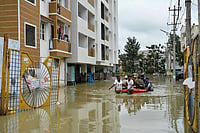That exaggerated sense of well-being was one factor that persuaded the NDA to go to the polls early, where it learnt to its consternation that the voters did not buy the picture of ‘India Shining’. Does anyone remember that absurd series of ads now?
The NDA was not the only one which got it terribly wrong. Much of the mainstream English print and electronic media too swallowed, and then uncritically propagated, the ‘feelgood’ factor. There was something more troubling about this disconnect between perceptions and reality, one which reflects a larger divide in India’s economy and society.
Of course, there are many sectors of the economy that were doing well at the beginning of the year, are continuing to do well and promise to do so in the near term. It’s not just the IT and the BPO segments that are booming. Banking, insurance, media, telecom, automobiles, hospitality and organised retailing are some other areas where things have never been better. If you are well-educated and have the skills for these businesses, the opportunities are immense. This is why the choices before the young, educated and skilled Indian are no longer confined to engineering, medicine or a position in the public sector banks. However, visible as these success stories are in urban India, they employ only a sliver of the population. For the vast majority in the towns and villages, the grind is as bleak as ever.
The social, economic and geographic divide in India is not a new phenomenon. But the transformation in ‘globalised’ India has given the divide a new edge. There is now what is best called Enclave India that at work, home, schooling and recreation is cut off from the larger India—figuratively and sometimes even literally. The citizens of Enclave India at the upper echelons work in office environments that rival the best in the world, often live in gated communities, the children go to ‘international’ schools and they entertain themselves by visiting malls, multiplexes and amusement parks or taking a holiday abroad. There are others at lower levels too who do not enjoy the same degree of comfort, but have yet benefited from the boom. The population in Enclave India is by no means small. As a proportion, it may add up to between just 5-10 per cent of the total population, in absolute numbers this still means between 50-100 million people.
Visible Enclave India is in the cities, but the ‘other’ India remains much the larger one. If you live in states like Bihar, MP and UP, you are more likely to be part of the other India. If you earn your living from agriculture, you are also likely to be the part that has been abandoned by the wayside. If you have a college degree, but can neither speak English reasonably well nor possess IT skills, you’ll be a member of the legions of educated unemployed. And if you do not possess an education to speak of, there is nothing the India of the 21st century can offer you.
When it coined the ‘Aam Aadmi’ slogan for the May ’04 elections, the slow-footed Congress may have for once demonstrated that it had a better feel for the pulse of the people. But it did not need the elections to tell us that there was a disconnect between two parts of the same country. The wave of suicides by farmers in peninsular India demonstrated the hollowness of the ‘India Shining’ slogan. Never before was that often-cited opening sentence from ‘A Tale of Two Cities’ more relevant than in 2004: "It was the best of times, it was the worst of times."
By the end of the year, Enclave India seems to have recovered from the shock of Verdict 2004. Industry is growing at the fastest rate in years, likewise for exports. The IT boom is back too. In spite of an erratic monsoon, the economy is expected in fiscal 2004-05 to grow by 6-6.5 per cent, and remain among the fastest growing global economies. The stockmarkets, which had voted with their feet soon after the elections, have more than recovered their losses. Nobody could explain the collapse of May ’04, nor could they explain the new peaks. In December ’04, the promise of a new model of economic reform is beginning to fade. Life remains much the same for the other, and larger, India.
The new year will be good for some of us, but it will bring few rewards for most of our fellow citizens. Enclave India will thrive. But how long can one, small section race ahead while the larger one is mired in despair?
(The author is editor, Economic and Political Weekly, Mumbai)






















